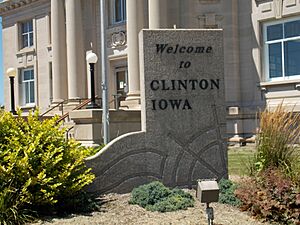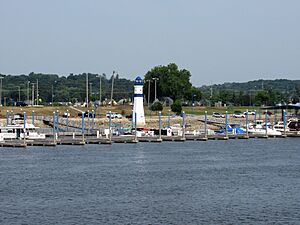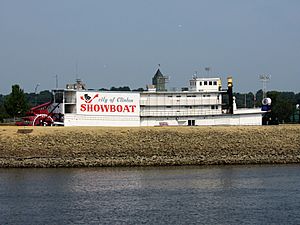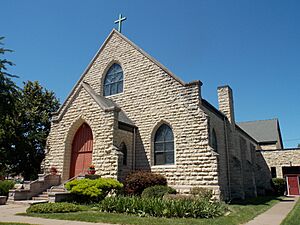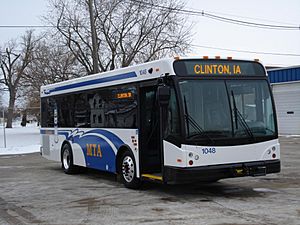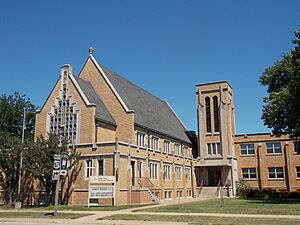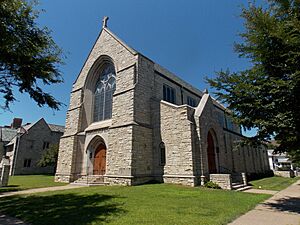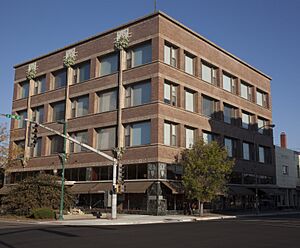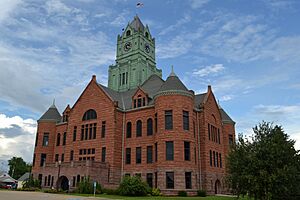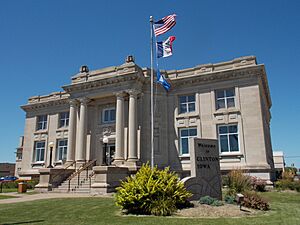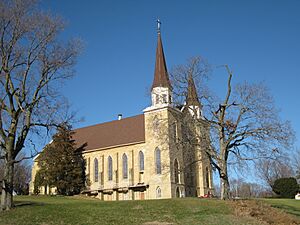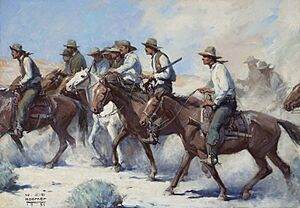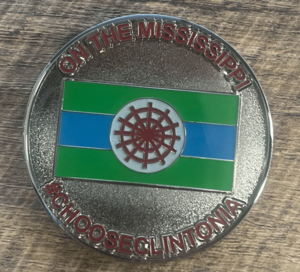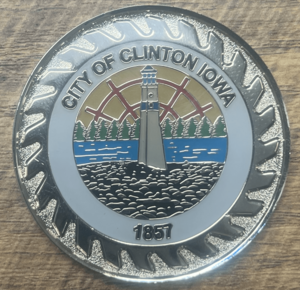Clinton, Iowa facts for kids
Quick facts for kids
Clinton, Iowa
|
||
|---|---|---|
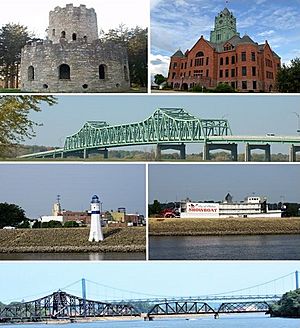
Top row: Eagle Point Park, Clinton County Courthouse; Second row: Mark Morris Memorial Bridge, Third row: Clinton Riverfront, Clinton Area Showboat Theatre; Bottom row: Gateway Bridge behind the Clinton Railroad Bridge
|
||
|
||
| Motto(s):
So many things to do - With a river view!
|
||

Location in the state of Iowa
|
||
| Country | ||
| State | ||
| County | Clinton | |
| Incorporated | January 26, 1857 | |
| Named for | DeWitt Clinton | |
| Area | ||
| • Total | 38.46 sq mi (99.62 km2) | |
| • Land | 35.60 sq mi (92.20 km2) | |
| • Water | 2.86 sq mi (7.42 km2) | |
| Elevation | 600 ft (185 m) | |
| Population
(2020)
|
||
| • Total | 24,469 | |
| • Rank | 18th in Iowa | |
| • Density | 687.33/sq mi (265.38/km2) | |
| • Summer (DST) | UTC−5 | |
| ZIP codes |
52732-52734, 52736, 52771
|
|
| Area code(s) | 563 | |
| FIPS code | 19-14430 | |
| GNIS feature ID | 0455480 | |
| Website | http://www.cityofclintoniowa.us/ | |
Clinton is a city in Iowa, United States. It is the main city of Clinton County. The city is located right next to the Mississippi River. In 2020, about 24,469 people lived there.
Clinton was named after DeWitt Clinton, who was a governor of New York. The city officially became a town on January 26, 1857. It is the most important city in the Clinton Micropolitan Statistical Area, which covers all of Clinton County.
Contents
History of Clinton, Iowa
The first European-American settlers came to the Clinton area in the 1830s. A man named Elijah Buell started the town of Lyons in 1837. He named it after the city of Lyon in France.
Around the same time, in 1836, Joseph Bartlett planned out the town of New York. He was hoping to find gold in the area.
Growth and Industry
In 1855, a railroad company decided to build a bridge over the Mississippi River near Little Rock Island. The Iowa Land Company then named the town "Clinton" to honor Governor DeWitt Clinton. The city officially adopted its charter in 1857.
As the bridge was being built, Clinton's population grew quickly. By 1859, the railroad line reached Cedar Rapids. The original single-track railroad bridge was later replaced with a double-track bridge in 1909.
Between the 1850s and 1900, Lyons and Clinton became major centers for the lumber industry. They were even known as the "Lumber Capital of the World." During the 1880s and 1890s, Clinton had more millionaires per person than almost any other city in the country!
In 1895, the town of Lyons officially joined with the city of Clinton.
Changes and Modern Times
By the early 1900s, most of the northern forests were used up, and the sawmills closed. But Clinton still had its railroads and the river, which made it easy to transport goods. This attracted new factories and heavy industries to the city. Many beautiful Victorian mansions built during the lumber boom can still be seen today.
In 1925, Clinton added Eagle Point Park to its park system. The Gateway Bridge (Illinois-Iowa) opened in 1956, connecting Clinton to Illinois.
In 1965, the Mississippi River flooded Clinton and many other cities. To prevent future floods, the U.S. Army Corps of Engineers built a large levee (a protective wall) around the city. This project was completed in 1981.
In 2005, Clinton was recognized as an "Iowa Great Place." This award helped the city get money to improve its riverfront. In 2009, Archer Daniels Midland built a new power plant in Clinton, creating more jobs.
Recently, many businesses like Big River Packaging, Nestle Purina, and Archer Daniels Midland have grown in Clinton. They have added hundreds of new jobs and invested a lot of money into the community. This has led to new homes, restaurants, and fun places to visit.
In 2020, Clinton received another grant from 'Iowa Great Places' for a project called 'Even More Things to Do with a River View.' These funds were used to make the city's riverfront even better and easier for everyone to enjoy.
In 2023, the old Clinton High School was taken down, and a brand new one opened for students. Also, a big concert called 'Tailgate N' Tallboys' brought almost 9,000 people to Clinton for three days of music.
Geography and Climate
Clinton is located at 41°50′49″N 90°12′26″W / 41.84694°N 90.20722°W.
The city covers about 38 square miles (99 square kilometers). Most of this area is land, with a smaller part being water.
Clinton sits on the western side of the Mississippi River. It is the easternmost city in Iowa. The Upper Mississippi River National Wildlife and Fish Refuge runs along the river through Clinton. The widest part of the Mississippi River, about 1.8 miles (2.9 km) across, is located above Lock and Dam No. 13 near Clinton.
Weather in Clinton
| Climate data for Clinton, Iowa (1991–2020 normals, extremes 1893–present) | |||||||||||||
|---|---|---|---|---|---|---|---|---|---|---|---|---|---|
| Month | Jan | Feb | Mar | Apr | May | Jun | Jul | Aug | Sep | Oct | Nov | Dec | Year |
| Record high °F (°C) | 69 (21) |
73 (23) |
87 (31) |
94 (34) |
102 (39) |
107 (42) |
109 (43) |
106 (41) |
103 (39) |
92 (33) |
80 (27) |
74 (23) |
109 (43) |
| Mean maximum °F (°C) | 51.3 (10.7) |
55.8 (13.2) |
71.5 (21.9) |
81.7 (27.6) |
88.0 (31.1) |
92.0 (33.3) |
93.7 (34.3) |
92.0 (33.3) |
89.2 (31.8) |
82.4 (28.0) |
68.2 (20.1) |
54.7 (12.6) |
95.0 (35.0) |
| Mean daily maximum °F (°C) | 29.4 (−1.4) |
34.3 (1.3) |
48.2 (9.0) |
62.1 (16.7) |
72.8 (22.7) |
81.1 (27.3) |
83.9 (28.8) |
81.6 (27.6) |
75.8 (24.3) |
63.1 (17.3) |
47.6 (8.7) |
34.6 (1.4) |
59.5 (15.3) |
| Daily mean °F (°C) | 21.9 (−5.6) |
26.3 (−3.2) |
38.7 (3.7) |
51.0 (10.6) |
62.1 (16.7) |
71.1 (21.7) |
74.4 (23.6) |
72.2 (22.3) |
65.3 (18.5) |
53.0 (11.7) |
39.3 (4.1) |
27.5 (−2.5) |
50.2 (10.1) |
| Mean daily minimum °F (°C) | 14.3 (−9.8) |
18.4 (−7.6) |
29.1 (−1.6) |
40.0 (4.4) |
51.3 (10.7) |
61.1 (16.2) |
64.8 (18.2) |
62.8 (17.1) |
54.7 (12.6) |
43.0 (6.1) |
30.9 (−0.6) |
20.5 (−6.4) |
40.9 (4.9) |
| Mean minimum °F (°C) | −10.3 (−23.5) |
−3.8 (−19.9) |
8.3 (−13.2) |
24.0 (−4.4) |
35.3 (1.8) |
48.1 (8.9) |
53.7 (12.1) |
52.5 (11.4) |
38.7 (3.7) |
25.7 (−3.5) |
12.6 (−10.8) |
−1.4 (−18.6) |
−14.1 (−25.6) |
| Record low °F (°C) | −29 (−34) |
−29 (−34) |
−15 (−26) |
7 (−14) |
24 (−4) |
37 (3) |
41 (5) |
39 (4) |
19 (−7) |
7 (−14) |
−8 (−22) |
−27 (−33) |
−29 (−34) |
| Average precipitation inches (mm) | 1.45 (37) |
1.68 (43) |
2.32 (59) |
3.40 (86) |
4.39 (112) |
4.74 (120) |
3.89 (99) |
4.20 (107) |
3.69 (94) |
2.64 (67) |
2.19 (56) |
1.86 (47) |
36.45 (926) |
| Average snowfall inches (cm) | 9.2 (23) |
7.5 (19) |
3.9 (9.9) |
0.8 (2.0) |
0.0 (0.0) |
0.0 (0.0) |
0.0 (0.0) |
0.0 (0.0) |
0.0 (0.0) |
0.3 (0.76) |
2.3 (5.8) |
7.9 (20) |
31.9 (81) |
| Average precipitation days (≥ 0.01 in) | 9.9 | 8.1 | 9.9 | 11.4 | 12.7 | 11.9 | 9.4 | 9.5 | 8.2 | 9.0 | 8.5 | 9.8 | 118.3 |
| Average snowy days (≥ 0.1 in) | 6.7 | 5.2 | 2.8 | 0.6 | 0.0 | 0.0 | 0.0 | 0.0 | 0.0 | 0.2 | 1.3 | 5.8 | 22.6 |
| Source: NOAA | |||||||||||||
People of Clinton
| Historical population | |||
|---|---|---|---|
| Census | Pop. | %± | |
| 1870 | 6,129 | — | |
| 1880 | 9,052 | 47.7% | |
| 1890 | 13,619 | 50.5% | |
| 1900 | 22,698 | 66.7% | |
| 1910 | 25,577 | 12.7% | |
| 1920 | 24,161 | −5.5% | |
| 1930 | 25,726 | 6.5% | |
| 1940 | 26,270 | 2.1% | |
| 1950 | 30,379 | 15.6% | |
| 1960 | 33,589 | 10.6% | |
| 1970 | 34,719 | 3.4% | |
| 1980 | 32,828 | −5.4% | |
| 1990 | 29,201 | −11.0% | |
| 2000 | 27,772 | −4.9% | |
| 2010 | 26,885 | −3.2% | |
| 2020 | 24,469 | −9.0% | |
| U.S. Decennial Census | |||
As of the 2020 census, Clinton had 24,469 people living in 10,440 households. The city's population density was about 687 people per square mile.
Most of the people in Clinton (85.9%) are White. About 5.1% are Black or African American, and 4.3% are Hispanic or Latino.
The average age in Clinton is 41.4 years old. About 26.7% of households have children under 18 living with them.
Fun Things to Do in Clinton

Clinton has many parks and fun activities for everyone!
- Eagle Point Park is a huge 164-acre park on a bluff overlooking the Mississippi River. It has a lodge, a nature center, playgrounds, a dog park, a Disc Golf course, and hiking trails. You can also find picnic areas, a waterfall, and a cool stone castle there!
- Riverview Park is another large park (65 acres) right on the Mississippi River. It features a marina (where boats are kept), restaurants, boat ramps, Pickleball courts, and sand volleyball courts. There are also baseball fields, a swimming pool, a skate park, and a special theater called the Showboat Theatre. It's also home to the LumberKings baseball team stadium.
- Other parks in Clinton include Dewitt Park, Clinton Park, Chancy Park, Rotary Park, Hawthorne Park, Emma Young Park, and Lyons Four Square Park.
- The Clinton Fitness Court is located on the Riverfront. It's an outdoor gym that helps people of all ages and abilities stay healthy and active.
- The Parks and Recreation Department offers over 170 different programs. These programs are designed for all ages, from young children to adults and seniors.
- Clinton has many walking and biking trails all over town.
- The Ericksen Community Center is where the Parks and Recreation Department is located. It has three softball fields, four tennis courts, a cross-country running trail, a playground, and a public pond.
- The Jurgensen Soccer Complex was updated in 2020. It now has flat fields that are easy for children, parents, and families of all ages and abilities to enjoy soccer.
Places to Visit in Clinton
Clinton has many interesting places to visit:
- The Bickelhaupt Arboretum is a beautiful 14-acre garden with many different kinds of plants.
- The Felix Adler Children's Discovery Center is a fun place for kids to learn about science, art, and different cultures.
- The Sawmill Museum teaches visitors about the history of the lumber industry and Clinton. It's a great place for families.
- The Clinton Area Showboat Theatre is a professional theater that performs plays in an old steamboat on the Mississippi River during the summer.
- Clinton has several Military Attractions that honor veterans. These include the 9/11 Memorial, the Veterans Memorial (with the famous Crunelle WWI Statue), a painted freedom rock, and "Hometown Hero Banners" hung in downtown every summer.
- The Lumber Kings Baseball team plays at NelsonCorp Field. It's a great way to enjoy a baseball game by the river.
- The Lyons Farmers Market is held every Saturday and Wednesday at Lyons Four Square Park. You can find fresh produce and local goods there.
- Clinton has a growing collection of Public Art, including murals and signs like the "I Believe in Clinton" campaign. There's also "The Grove," a small park that shows off local artists' work.
- The Clinton County Historical Society is a museum in downtown Clinton. It helps preserve the history of Clinton County and the city.
Getting Around Clinton
Several major roads pass through Clinton, including U.S. Route 30 (also known as the Lincoln Highway), U.S. Route 67 (Great River Road), and Iowa Highway 136.
For air travel, the closest major airport is the Quad City International Airport in Moline, Illinois, which is about 40 miles away. Chicago's O'Hare International Airport is about 140 miles east.
Clinton also has its own airport, the Clinton Municipal Airport (KCWI). It has two runways and is used for general aviation.
Major railroads like the Union Pacific Railroad and the Canadian Pacific also run through Clinton.
The Mississippi River Trail, a national recreation trail, also passes through the city.
Within Clinton, residents can use the MTA bus system. It has 6 bus routes that go all over the city. There's also a special service for disabled residents.
Schools in Clinton
Clinton has several schools for students of all ages.
- Prince of Peace Catholic Academy is a private Catholic school for students from kindergarten through 12th grade.
The Clinton Community School District is a public school district that includes:
- Clinton High School
- Clinton Middle School
- Jefferson Elementary
- Whittier Elementary
- Eagle Heights Elementary
- Bluff Elementary
For students who learn better in a different setting, there's Gateway Area Community Center, an alternative high school. The Lighthouse School offers a boarding and computer-based learning program.
For college students, Eastern Iowa Community Colleges has a branch in Clinton called Clinton Community College.
Places of Worship
Clinton is home to many different churches and places of worship:
- Catholic Church
- Jesus Christ, Prince of Peace Catholic Parish
- Lutheran Churches
- St. Paul Lutheran Church
- Faith Center Church
- Trinity Lutheran Church
- Zion Evangelical Lutheran Church
- St. John Lutheran Church
- LDS
- Church Of Jesus Christ of Latter-Day Saints
- Non-denominational Christian Churches
- Journey
- River Church
- Baptist Church
- Gateway Baptist Church
- Calvary Baptist Church
- First Baptist Church
- Islamic Mosque
- Clinton Islamic Center
- Methodist Church
- First Methodist Church
Culture and Organizations
Clinton has many cultural spots and organizations:
- The Bickelhaupt Arboretum is a beautiful place to see plants and learn about nature.
- The Clinton Area Showboat Theatre offers live professional theater performances.
- The Felix Adler Discovery Center is a hands-on museum for children.
- The Clinton County Historical Society helps preserve and share the history of the area.
- The Sawmill Museum teaches about Clinton's past as a lumber capital.
- The Soaring Eagle Nature Center is a great place to learn about local wildlife and nature.
- The Clinton Symphony Orchestra performs concerts at the Vernon Cook Theater at Clinton High School.
Famous Buildings in Clinton
Clinton has several important and historic buildings.
National Historic Landmark
- The Van Allen Building was designed by the famous architect Louis Sullivan and finished in 1914. It's a very special building that is now used for businesses and homes in downtown Clinton. It became a National Historic Landmark in 1976.
Buildings on the National Register of Historic Places
Many other buildings in Clinton are listed on the National Register of Historic Places, meaning they are important to the country's history:
- The Clinton County Courthouse was built between 1892 and 1897. It has red sandstone and granite walls, and its tower is made of copper that has turned green over time.
- The Clinton Public Library was built in 1903-1904 with money from Andrew Carnegie. It has a grand entrance with columns and is made of limestone.
- The Lafayette Lamb House (now the YWCA) was built in 1877. It was later updated in 1906.
- The City National Bank (now First National Bank) was built in 1911-1912 in a classic style.
- The Howes Building was built in 1900 and has decorative red brick and terracotta.
- The Ankeny Building was built in 1930 in the Art Deco style. Today, it holds many businesses.
- The Moeszinger-Marquis (Armstrong) Building was built in 1891 and was used for wholesale hardware businesses for many years.
- The George M. Curtis Mansion (now the Women's Club) was built in 1883-1884. It's known for its many stained glass windows, carved wood, and large fireplaces.
- The Castle Terrace Historic District was planned in 1892. It shows off different architectural styles, mostly Tudor Gothic.
- Cherry Bank is a two-story brick house built in 1870-1871.
- Saint Irenaeus Church was built between 1864 and 1871 in the Gothic Revival style.
Famous People from Clinton
Many notable people have connections to Clinton, Iowa:
- Felix Adler (1895-1960), known as the "King of Clowns" for the Ringling Brothers Circus.
- Matt Bentley, a professional wrestler.
- Marquis Childs (1903-1990), a Pulitzer Prize-winning writer.
- Muriel Frances Dana (1916-1997), a child actress from silent films.
- Dale Gardner (1948-2014), a NASA astronaut.
- Salvatore Giunta, a U.S. Army Staff Sergeant and the first living person since the Vietnam War to receive the Medal of Honor.
- Col. David Hilmers, a former NASA astronaut.
- David Johnson, a professional football player for the Arizona Cardinals.
- W. H. D. Koerner (1878-1938), an artist famous for his illustrations and paintings.
- Lillian Russell (1861-1922), a famous singer and actress.
- Duke Slater (1898-1966), an All-American college football player and the first Black lineman in NFL history. He also became a municipal judge in Chicago.
- George Stone (1876-1945), a Major League Baseball player who won a batting title.
- Krista Voda, a sportscaster for Fox Sports.
- LaMetta Wynn (1933-2021), the first African-American woman elected as mayor of a city in Iowa.
Businesses in Clinton
Clinton has been home to many important businesses throughout its history:
- Gray & Lunt (1857) and C. Lamb & Sons (around 1874) were major sawmills and lumber companies during Clinton's lumber boom.
- Curtis Bros. & Co (1866–1966) made house finishing products.
- Van Allen and Company Department Store (around 1912–1914) was a large department store in the Van Allen Building.
- Flav's Fried Chicken (2011) was a restaurant co-founded by Flavor Flav.
Today, Clinton is home to many active businesses:
- ADM (Archer-Daniels-Midland) (1982–Present) is a large food processing company.
- Atlas Roofing Corporation makes hardware equipment.
- Big River Packaging designs and makes paperboard packaging.
- The Clinton LumberKings are a collegiate summer baseball team.
- Custom-Pak makes industrial plastic parts.
- LyondellBasell develops and supplies many different products.
- Nestle Purina makes pet and farm animal products.
- Timken makes transmission products.
|
See also
 In Spanish: Clinton (Iowa) para niños
In Spanish: Clinton (Iowa) para niños



